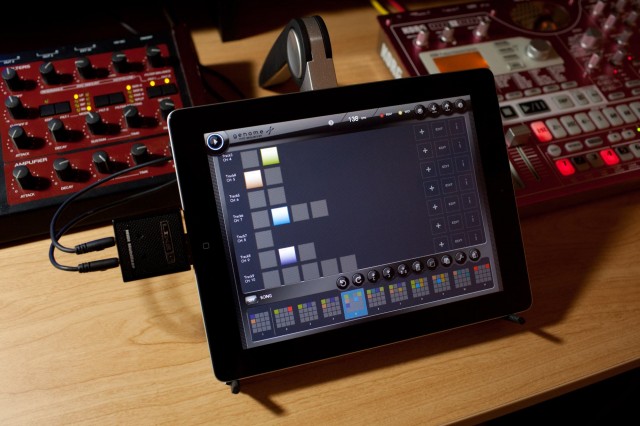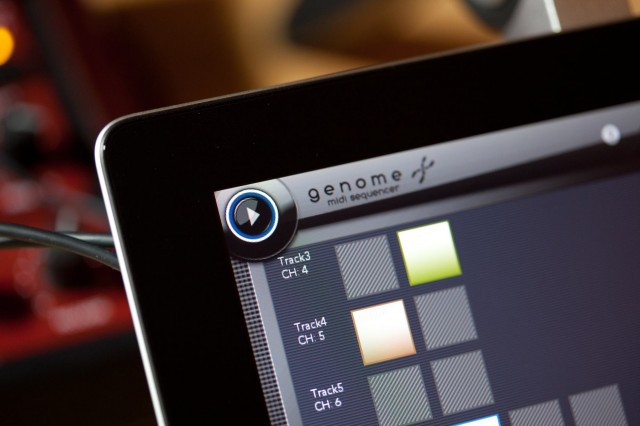The tablet – or at least the iPad – is beginning to look like a terrific accessory for lovers of MIDI and hardware. With its compact form factor, it coexists nicely with your MIDI gear and lets you focus on sequencing, perhaps moving to the traditional computer to finish up your track, mixing, and the like.
And it’s spawning MIDI sequencer apps that imaginatively explore ideas for how to create sequencing, all with an immediate touchable interface.
The latest entry: Genome MIDI Sequencer claims to be the “first true pattern-based MIDI sequencer for iPad.” The word “true” might be debateable, but it looks thoroughly full-featured, with clock sync, MIDI import / export (ideal for working with your desktop Mac or PC), and other must-have portable sequencing features:
- Hard-line MIDI support: Core MIDI, Camera Connection Kit, Line 6 Mobilizer Mk I and Mk II compatibility
- Wireless MIDI: Network MIDI support (works with Mac and, via other support, Linux and Windows)
- MIDI Clock: Start, stop / send, receive
- Lots o’ messages: Note On, Note Off, Pitch Bend, Aftertouch, Channel Pressure and CC’s
- Pattern-based; pattern changes occur on bar boundaries so song stays in sync Ed., oh, come on, where’s the fun in that? 😉
- 16 simultaneous tracks, unlimited patterns
There’s also an on-screen keyboard interface (in case you don’t have a MIDI keyboard handy), song and live modes, incoming CC and note recording, and undo/redo for “most” actions.
Having the multichannel capability alone is a must for people with big studios.
Developer Dave Wallin says he’s been working on this for some time. An experienced dev with tools like bleep!BOX and bleep!Synth under his belt for iOS (as well as Additive and Zero Vector for desktop), he’s got a good perspective on the bigger picture.
Since Dave is a user as well as a developer (as is often the case with music tech), I asked him to tell us a bit more about the app, his thoughts on development, and how you might use this.
He even has some good thoughts, in case you’re wondering, about how this compares with and fits in with desktop studios.
CDM: This looks to me to be the most full-featured MIDI sequencer we’ve seen yet, more than just a pattern or step sequencer (though I like those sorts of things, too). That said, what other applications do you like in terms of MIDI control?
Dave: There are a couple other apps that look close in terms of functionality like Step Poly Arp, Polychord and Brainwave Sequencer. The first two are more focused on ‘performance’ imo with Brainwave being the closer. I wanted to provide some of the functionality you’d expect from a desktop sequencing app but redesign the core interface around touch and just make it simple and fun to use. My inspirations for how the piano roll works are 50% monome / [Yamaha] Tenori-on (in terms of a familiar grid and easy one-tap note entry) and 50% iPad paint application (in terms of using gestures to navigate). It also takes some inspiration from [Nintendo] Game Boy tracking apps in that I keep the octave / bar navigation locked to a grid. GMS isn’t locked into 16 step patterns and you can adjust the grid and bar length more freely than some other apps.
Ed.: Of course, at iPad app prices, you can easily pick up all the apps above, and they all have some appeal – yes, I know it’s time for another iPad app round-up. A MIDI-specific one could be fun; I’ll work on it! -PK
How are you using this in your studio – what gear are you using?
Right now I am using it with my [Access] Virus b (desktop [synth]) and a drum machine primarily. It’s great with the Virus since it can do up to 16 parts and I can save these setups and easily recall them later without having to worry about program changes or anything like that. The drum machine saves me from having to waste Virus parts on drums. With just those two pieces of gear and not much else I can make some pretty decent sounding songs. My current work flow is to jam around a bit with Genome and the gear and when I come up with something good, record some loops or tracks it and bring it over to the desktop for additional processing and arrangement. My actual studio doesn’t even have a computer in it at the moment – it’s in a totally seperate room.
At what point do you imagine people would use the iPad sequencer versus, say, the sequencer on their desktop machine?
What I have learned from my own experience and from talking to other people is that the iPad is not a total replacement for the desktop or even for a laptop, unless you’re doing some very minimal stuff. The iPad is more of a convenience and leisure device at this point. I have limited time to relax and if I can spend 30 minutes chilling on the couch, making a tune on my iPad, it’s a win for me. It doesn’t have to be a whole song – it could be some musical ideas, sounds or loops that I end up using later on the desktop or in another app.
With Genome, I think the big wins are portability and ease of use. If I want to jam with a friend, I can throw my iPad in a bag and bring it with me. Sometimes I don’t want to have to deal with all the overhead that comes with a desktop sequencing application like hardware setup, configuring plugin directories, or GUI’s that are packed to the brim with controls. GMS is very easy to plug in and get started within a few seconds.
I’m curious about your reaction to the Open Music App Collaboration Manifesto posted recently. [See Synthtopia coverage.] Any of these issues relevant to your work? What would you like to see in terms of inter-app integration?
I actually just posted some thoughts on this to their Google Group this morning. My response is here:
http://groups.google.com/group/open-music-app-collaboration/browse_thread/thread/75cdd385048fa3ce
Communicating with other apps on the same device is something that I think Genome will be very good for (after some minor updates). Right now, not a lot of apps support Network MIDI, let alone regular CoreMIDI. How well this works will depend on a lot of factors and we’ll just have to wait and see how extensively it’s adopted, both by developers and by users. I could imagine an ecosystem where you can string a bunch of apps together and make songs. The first step right now is to come up with a spec for developers to implement and maybe a way to certify that apps have implemented it properly. If done well, I think there could be some good cross-promotion opportunities to entice developers to do it and it could catch on, much like with Audio Copy did.
Had you evaluated Android at all, or other platforms?
Some work is being done to port libNUI [C++ framework] (which I use for all my apps currently) to Android, however it seems the state of MIDI on Android is nowhere near what it is on iOS. If some well known hardware makers make an accessory or if a good SDK becomes available, I would definitely look into it. GMS is being ported to a Mac desktop app and will be available in the Mac App Store at some point. The desktop version will be almost identical, except for some changes made to adapt it to work with a mouse, instead of multitouch. I think a simple, cheap MIDI sequencer will be attractive to some people and the amount of time to port it is minimal for me.
Ed.: Hopefully more to say about the state of Android MIDI soon; while wired accessories may not be as convenient, wireless MIDI, especially via Bluetooth, holds some promise. I can certainly make a good argument *against* a developer immediately rushing to support Android, but it remains something we’re watching. I also hear these computer things can do MIDI. -PK
US$12.99 in the iTunes App Store, for iPad (iOS 4.2+)
http://www.whitenoiseaudio.com/apps/genome-midi-sequencer/
http://www.whitenoiseaudio.com/

